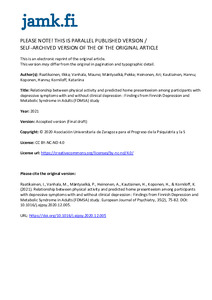Relationship between physical activity and predicted home presenteeism among participants with depressive symptoms with and without clinical depression. Findings from Finnish Depression and Metabolic Syndrome in Adults (FDMSA) study
Raatikainen, I.; Vanhala, M.; Mäntyselkä, P.; Heinonen, A.; Kautiainen, H.; Koponen, H.; Korniloff, K. (2021)
Raatikainen, I.
Vanhala, M.
Mäntyselkä, P.
Heinonen, A.
Kautiainen, H.
Koponen, H.
Korniloff, K.
Elsevier
2021
Julkaisun pysyvä osoite on
https://urn.fi/URN:NBN:fi-fe2023030329574
https://urn.fi/URN:NBN:fi-fe2023030329574
Tiivistelmä
Background and objectives
Depression can pose a major threat to an individual’s ability to cope with daily activities. The aim of this study was to explore the relationship between physical activity (PA) and predicted home presenteeism (PHP) among depressive participants. The relationship between PHP and the severity of depressive symptoms was also investigated.
Methods
A total of 760 participants with depressive symptoms (DS) aged ≥35 years participated in this study. The study was conducted between 2008 and 2016 in municipalities within the Central Finland Hospital District. DS were determined with the 21-item Beck Depression Inventory (BDI-21) with a cutoff score ≥10, and psychiatric diagnoses were confirmed by the Mini-International Neuropsychiatric Interview (M.I.N.I.). PA, home presenteeism and other social-clinical factors were captured by standard self-administered questionnaires.
Results
Higher PA levels were associated with lower PHP (adjusted) among depressive patients with (p < 0.001) and without clinical depression (p = 0.021). In addition, DS (adjusted BDI) correlated with PHP (r = 0.60, 95% Cl: 0.56–0.65) in such a way that the higher the BDI was, the higher the PHP was. Moreover, home presenteeism were higher among depression diagnosed participants than those without (p = 0.002).
Conclusion
According to this study, PA is associated with PHP among depressive patients in the Finnish adult population. PA seems to promote the ability to cope better with daily activities at home despite DS or a depression diagnosis. These findings outline the importance of being physically active regarding independency of daily activities, and thus, should be considered in clinical practices when treating depressive patients.
Depression can pose a major threat to an individual’s ability to cope with daily activities. The aim of this study was to explore the relationship between physical activity (PA) and predicted home presenteeism (PHP) among depressive participants. The relationship between PHP and the severity of depressive symptoms was also investigated.
Methods
A total of 760 participants with depressive symptoms (DS) aged ≥35 years participated in this study. The study was conducted between 2008 and 2016 in municipalities within the Central Finland Hospital District. DS were determined with the 21-item Beck Depression Inventory (BDI-21) with a cutoff score ≥10, and psychiatric diagnoses were confirmed by the Mini-International Neuropsychiatric Interview (M.I.N.I.). PA, home presenteeism and other social-clinical factors were captured by standard self-administered questionnaires.
Results
Higher PA levels were associated with lower PHP (adjusted) among depressive patients with (p < 0.001) and without clinical depression (p = 0.021). In addition, DS (adjusted BDI) correlated with PHP (r = 0.60, 95% Cl: 0.56–0.65) in such a way that the higher the BDI was, the higher the PHP was. Moreover, home presenteeism were higher among depression diagnosed participants than those without (p = 0.002).
Conclusion
According to this study, PA is associated with PHP among depressive patients in the Finnish adult population. PA seems to promote the ability to cope better with daily activities at home despite DS or a depression diagnosis. These findings outline the importance of being physically active regarding independency of daily activities, and thus, should be considered in clinical practices when treating depressive patients.
